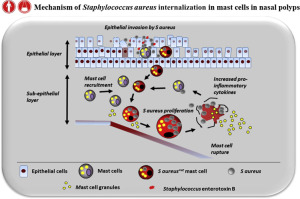当前位置:
X-MOL 学术
›
J. Allergy Clin. Immunol.
›
论文详情
Our official English website, www.x-mol.net, welcomes your
feedback! (Note: you will need to create a separate account there.)
Staphylococcus aureus internalization in mast cells in nasal polyps: Characterization of interactions and potential mechanisms.
Journal of Allergy and Clinical Immunology ( IF 11.4 ) Pub Date : 2019-06-27 , DOI: 10.1016/j.jaci.2019.06.013 Stephen M Hayes 1 , Timothy C Biggs 1 , Simon P Goldie 1 , Philip G Harries 2 , Andrew F Walls 3 , Raymond N Allan 4 , Sylvia L F Pender 3 , Rami J Salib 1
Journal of Allergy and Clinical Immunology ( IF 11.4 ) Pub Date : 2019-06-27 , DOI: 10.1016/j.jaci.2019.06.013 Stephen M Hayes 1 , Timothy C Biggs 1 , Simon P Goldie 1 , Philip G Harries 2 , Andrew F Walls 3 , Raymond N Allan 4 , Sylvia L F Pender 3 , Rami J Salib 1
Affiliation

|
BACKGROUND
Chronic rhinosinusitis (CRS) with nasal polyps is a common chronic condition. The exact cause of nasal polyps remains unknown. Recently, we made the novel observation of intracellular localization of Staphylococcus aureus within mast cells in nasal polyps.
OBJECTIVE
This follow-up study aimed to further characterize interactions between S aureus and mast cells in this setting and elucidate potential internalization mechanisms with particular emphasis on the role of staphylococcal enterotoxin B (SEB).
METHODS
A prospective study was performed using an explant tissue model with ex vivo inferior turbinate mucosa obtained from patients with chronic rhinosinusitis with nasal polyps (n = 7) and patients without CRS (n = 5). Immunohistochemistry was used to characterize S aureus uptake into mast cells and investigate the effects of SEB on this process. An in vitro cell-culture model was used to investigate mast cell-S aureus interactions by using a combination of fluorescent in situ hybridization, confocal laser scanning microscopy, scanning electron microscopy, transmission electron microscopy, and proliferation assays.
RESULTS
S aureus was captured by extracellular traps and entered mast cells through phagocytosis. Proliferating intracellular S aureus led to the expansion and eventual rupture of mast cells, resulting in release of viable S aureus into the extracellular space. The presence of SEB appeared to promote internalization of S aureus into mast cells.
CONCLUSION
This study provides new insights into the interactions between S aureus and mast cells, including the internalization process, and demonstrates a prominent role for SEB in promoting uptake of the bacteria into these cells.
中文翻译:

鼻息肉肥大细胞中的金黄色葡萄球菌内在化:相互作用和潜在机制的表征。
背景技术带有鼻息肉的慢性鼻-鼻窦炎(CRS)是一种常见的慢性病。鼻息肉的确切原因尚不清楚。最近,我们对鼻息肉肥大细胞内金黄色葡萄球菌的细胞内定位进行了新颖的观察。目的这项后续研究旨在进一步表征金黄色葡萄球菌与肥大细胞之间在这种情况下的相互作用,并阐明潜在的内在化机制,尤其着重于葡萄球菌肠毒素B(SEB)的作用。方法采用从具有鼻息肉的慢性鼻-鼻窦炎患者(n = 7)和没有CRS的患者(n = 5)获得的离体下鼻甲粘膜的外植体组织模型进行前瞻性研究。免疫组织化学用于表征金黄色葡萄球菌摄取到肥大细胞中,并研究SEB在此过程中的作用。通过使用荧光原位杂交,共聚焦激光扫描显微镜,扫描电子显微镜,透射电子显微镜和增殖测定的组合,使用体外细胞培养模型研究肥大细胞与金黄色葡萄球菌的相互作用。结果金黄色葡萄球菌被细胞外捕获物捕获,并通过吞噬作用进入肥大细胞。增殖的细胞内金黄色葡萄球菌导致肥大细胞扩增并最终破裂,导致有活力的金黄色葡萄球菌释放到细胞外空间。SEB的存在似乎促进金黄色葡萄球菌内化进入肥大细胞。结论本研究为金黄色葡萄球菌与肥大细胞之间的相互作用提供了新的见解,
更新日期:2020-01-04
中文翻译:

鼻息肉肥大细胞中的金黄色葡萄球菌内在化:相互作用和潜在机制的表征。
背景技术带有鼻息肉的慢性鼻-鼻窦炎(CRS)是一种常见的慢性病。鼻息肉的确切原因尚不清楚。最近,我们对鼻息肉肥大细胞内金黄色葡萄球菌的细胞内定位进行了新颖的观察。目的这项后续研究旨在进一步表征金黄色葡萄球菌与肥大细胞之间在这种情况下的相互作用,并阐明潜在的内在化机制,尤其着重于葡萄球菌肠毒素B(SEB)的作用。方法采用从具有鼻息肉的慢性鼻-鼻窦炎患者(n = 7)和没有CRS的患者(n = 5)获得的离体下鼻甲粘膜的外植体组织模型进行前瞻性研究。免疫组织化学用于表征金黄色葡萄球菌摄取到肥大细胞中,并研究SEB在此过程中的作用。通过使用荧光原位杂交,共聚焦激光扫描显微镜,扫描电子显微镜,透射电子显微镜和增殖测定的组合,使用体外细胞培养模型研究肥大细胞与金黄色葡萄球菌的相互作用。结果金黄色葡萄球菌被细胞外捕获物捕获,并通过吞噬作用进入肥大细胞。增殖的细胞内金黄色葡萄球菌导致肥大细胞扩增并最终破裂,导致有活力的金黄色葡萄球菌释放到细胞外空间。SEB的存在似乎促进金黄色葡萄球菌内化进入肥大细胞。结论本研究为金黄色葡萄球菌与肥大细胞之间的相互作用提供了新的见解,











































 京公网安备 11010802027423号
京公网安备 11010802027423号